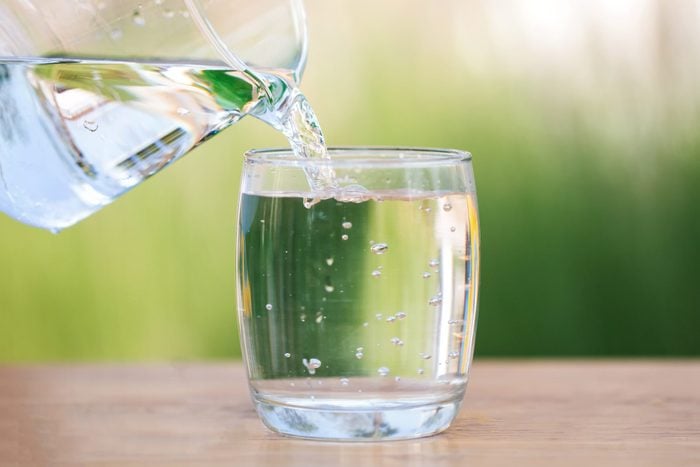Here’s How Much Water You Really Need in a Day, with Nutritional Scientists’ Latest Wisdom
Updated: Jul. 28, 2023

Is eight cups of water a day really the number to go for? The latest recommendations suggest that on average, Americans don't need to sip as much water as we've believed. Here's the data, for a healthy amount.
It’s not like someone telling you to drink more water is bad advice. In fact, out of all of the crazy diet culture myths that come from the Internet, drinking eight cups of water a day—or half of your body weight in ounces of water—isn’t a terrible idea. But it’s important to focus on hydration and getting enough fluids throughout the day—which can come from a variety of sources. According to Harvard Medical School’s blog, staying hydrated is important for so many key physiological functions, such as carrying nutrients and oxygen to your cells, flushing bacteria out of your bladder, aiding in digestion, normalizing blood pressure, protecting organs and tissues, and regulating your body temperature. Drinking enough water is also beneficial for cognitive performance and easing fatigue, tension and anxiety, according to the British Journal of Nutrition.
However, while hydration is important for your overall health, the recommended intake for water each day isn’t as high as many of us have believed. According to the U.S. National Academies of Sciences, Engineering, and Medicine, adequate daily fluid intake should be 15.5 cups (3.7 liters) of fluids for men and 11.5 cups (2.7 liters) for women. However, it’s important to note that the recommendation calls for adequate fluid intake—not just water. This means that other beverages and even hydrating foods count toward this daily total.
So, how much water do you need to drink to stay well hydrated? We’ve got the answer for males and females.
Get The Healthy @Reader’s Digest newsletter
Hydrating foods and drinks that help you reach your goal
About 20% of our fluid intake actually comes from the food we eat. According to the Harvard T.H. Chan School of Public Health, water-rich food—think lettuce, leafy greens, cucumbers, bell peppers, summer squash, celery, berries, and melons—can all contribute to your hydration.
Coffee and tea can also count toward to your daily hydration goals, despite past popular notions. In the past, some sources suggested caffeine could dehydrate you. However, research has determined that caffeine does not increase urine output during the day compared to other beverages. Because coffee and tea are made from a water base, they can in fact contribute to your daily water intake goal.
Plus, although there had been some previous debate, one 2016 study from the American Journal of Clinical Nutrition did find sparkling water to be just as hydrating as still water. The Center for Disease Control and Prevention also suggests drinks with beneficial macro- and micronutrients can also contribute to fluid intake. These include milk (for protein and calcium) and 100% fruit juices (for vitamin C).
However, alcohol does not contribute to fluid intake goals because of its dehydrating effects. When it’s consumed, alcohol suppresses the fluid-regulating hormone in the body that signals the kidneys to reduce urination, causing the body to flush it out and increase dehydration. This is why it’s important to drink water alongside alcohol to replenish your fluids.
10 Myths About Hydration You Need to Stop Believing Right Now
This is how much water to aim for each day
While the Dietary Guidelines for Americans do provide nutritional advice for the average consumer, there actually isn’t a set recommended dietary allowance for daily water intake.
However, the Dietary Reference Intake says that 35% to 54% of your daily fluid intake should be coming from water. So if you do the calculation, that’s around four to six cups of water for women, and five to eight cups of water for men.
The rest of your fluid intake can then come from other beverages and foods that are hydrating. Here are the 10 Most Hydrating Foods to Eat (Without Drinking Water).
For more wellness updates, follow The Healthy on Facebook, Instagram, and Twitter. Keep reading:
- Here’s How Much Protein You Really Need in a Day, with a Kidney Doctor’s Wisdom
- Eating More of This Can Improve Your Gut Health, Says New Science
- Here’s How Long You Need to Walk to Lower Your Blood Sugar, New Research Finds
- Here’s What Neil Patrick Harris Ordered on His First Date with David Burtka
- Here’s Why You Sweat So Much
